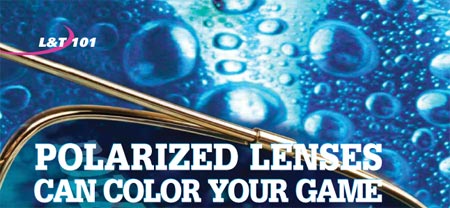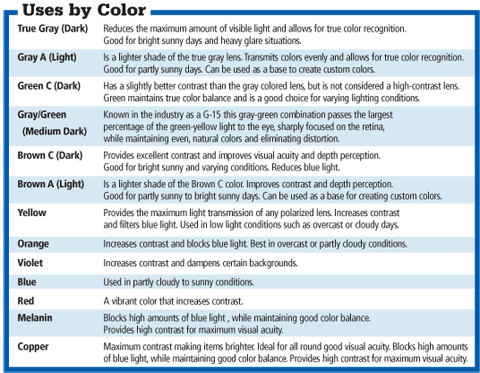
Photograph by Annie Gallagher/Black Box studio Frame: Marchon Eyewear, Nautica N5504S
By Michael DiSanto, ABOM
Whether it’s a mitt, clubs, spikes, helmet or pads, there is no more important piece of equipment than eyewear. When it comes to sports, words like big, strong and fast are important. But no matter what skills a person has, it all starts with vision. With the advent of spring, sporting activities will once again take to the outdoors. Over-brightness, glare, lack of contrast and the harmful effects of ultraviolet light will all work against a best performance, regardless of the game. Eyewear should rate very high on the list of equipment for your patients. And like all equipment there are products so bad that it hurts the participant’s game, there are products you can get by with and then there is the really good stuff the pros use. When it comes to vision the unquestioned choice of professionals is polarized eyewear.
In sports we react to what we see. We see by virtue of the light that enters our eyes. Without good sunwear, brightness and glare will diminish our best efforts. Glare results in a loss f visual performance, which is produced when an object or light source in the field-of-vision is brighter than the amount of light to which the eyes are adapted. Most tinted lenses will provide some absorption to dampen brightness, but only a polarized lens can effectively eliminate blinding glare. In addition to the immediate glare problems, polarized lenses protect against the long term results of ultraviolet exposure. Though invisible to the human eye, ultraviolet light presents risks to the delicate skin around the eyes bthe contributing to the formation of premature wrinkles and various cancers as well as to the tissues of the eye itself. Prolonged unprotected exposure can lead to ocular damage in the form of burns, pingueculas and pterygiums, as well as to the increased risk of cataracts and macular degeneration.
Regular non-polarized sun lenses indiscriminately filter all light whether it is horizontal or vertical. Glare is dampened, but not eliminated. More importantly, by filtering all components of light, visual acuity is diminished. On the other hand polarized lenses allow in the vertical component of light, which is preferred for clear vision while eliminating the easily scattered and skewed horizontal component of light. Vertically aligned light is preferred because it respects the natural tendency of the visual system to focus on the vertical component of an image. If two rods are placed in front of the eye at different distances, the eye has a strong tendency to assume a focus corresponding to the vertical rod. Polarized lenses maximize usable vertically aligned light, which leaves the portion of the image most likely to be focused upon the least distorted.
In addition to the basic benefits of polarizing lenses, the use of specific colors for particular activities can really sharpen a competitive edge. Depending on the sport certain lens colors can enhance contrast and sharpen the wearers perception thus speeding up reaction time or clarifying judgment. The laws of supply and demand rule the availability of any product and polarized lenses are no exception. In the past when these lenses were rarely used, difficult to produce and often failed due to de-lamination, they were only available in gray or brown with a very limited design choice. Fortunately the demand for higher performance has got the polarized market expanding. As a result there are a growing number of lens manufacturers adding and expanding polarized lens lines. Without too much difficulty optical dispensers can find a large variety of colors in availabilities from single vision to progressives. A once totally flat market of around 2 percent is finally moving up with an industry average polarized penetration of around 8 percent with the chains leading the way at about 12 percent. As the market grows, polarized color and design choices continue to grow.
Without a doubt, there is a lot more to choosing performance enhancing polarized lenses than there used to be, but an eyecare professional with some knowledge of the colors and the activities that they apply to can be a huge asset to the customer.
The polarized market is rising so a practice that specializes in performance polarized lenses can move their bottom line further away from red and more into the black as they enjoy the additional green that leadership brings.














